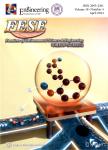Enhanced triallyl isocyanurate(TAIC)degradation through application of an 03/UV process:Performance optimization and degradation pathways
作者机构:State Key Joint Laboratory of Environment Simulation and Pollution ControlSchool of EnvironmentTsinghua UniversityBeijing 100084China School of Chemical&Environmental EngineeringChina University of Mining and TechnologyBeijing 100083China
出 版 物:《Frontiers of Environmental Science & Engineering》 (环境科学与工程前沿(英文))
年 卷 期:2020年第14卷第4期
页 面:103-113页
核心收录:
学科分类:083002[工学-环境工程] 0830[工学-环境科学与工程(可授工学、理学、农学学位)] 08[工学]
主 题:Triallyl isocyanurate O3/UV Advanced oxidation processes(AOP) Degradation pathway
摘 要:Triallyl isocyanurate(TAIC,C12H15N3O3)has featured in wastewater treatment as a refractory organic compound due to the significant production capability and negative environmental impact.TAIC degradation was enhanced when an ozone(O3)/ultraviolet(UV)process was applied compared with the application of an independent O3 process.Although 99%of TAIC could be degraded in 5 min during both processes,the O3/UV process had a 70%mineralization rate that was much higher than that of the independent O3 process(9%)in 30 min.Four possible degradation pathways were proposed based on the organic compounds of intermediate products identified during TAIC degradation through the application of independent 03 and O3/UV processes.pH impacted both the direct and indirect oxidation processes.Acidic and alkaline conditions preferred direct and indirect reactions respectively,with a pH of 9 achieving maximum Total Organic Carbon(TOC)removal.Both CO32-and HCO3-decreased TOC removal,however only CO32-negatively impacted TAIC degradation.Effects of Cl-as a radical scavenger became more marked only at high concentrations(over 500 mg/L Cl-).Particulate and suspended matter could hinder the transmission of ultraviolet light and reduce the production of HO·accordingly.



